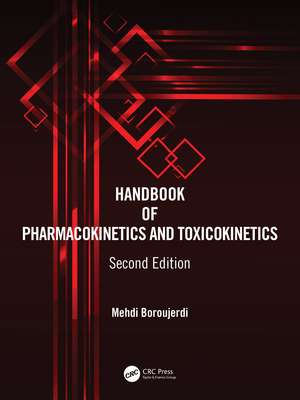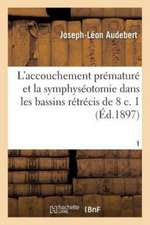Handbook of Pharmacokinetics and Toxicokinetics
Autor Mehdi Boroujerdien Limba Engleză Hardback – 22 aug 2023
Features:
- Comprehensive handbook on principles and applications of PK/TK appealing to a diverse audience including scientists and students
- An excellent text fully revised and fully updated for anyone interested in the theoretical and practical pharmacokinetics
- The systematic compilation of mathematical concepts and methodologies allows readers to decide on relevant concepts and approaches for their research
- Incorporates research relevant to SDGs and of interest to industrial and regulatory environmental scientists involved in chemical contamination research and regulatory decision making related to soil, water, and ocean
- Includes sections on applications and case studies
| Toate formatele și edițiile | Preț | Express |
|---|---|---|
| Paperback (1) | 330.06 lei 3-5 săpt. | +67.93 lei 6-12 zile |
| Taylor & Francis Ltd. – 19 dec 2024 | 330.06 lei 3-5 săpt. | +67.93 lei 6-12 zile |
| Hardback (1) | 1282.49 lei 18-23 zile | +123.00 lei 6-12 zile |
| CRC Press – 22 aug 2023 | 1282.49 lei 18-23 zile | +123.00 lei 6-12 zile |
Preț: 1282.49 lei
Preț vechi: 1564.02 lei
-18% Nou
Puncte Express: 1924
Preț estimativ în valută:
245.44€ • 254.07$ • 207.45£
245.44€ • 254.07$ • 207.45£
Carte disponibilă
Livrare economică 10-15 februarie
Livrare express 29 ianuarie-04 februarie pentru 132.99 lei
Preluare comenzi: 021 569.72.76
Specificații
ISBN-13: 9781032197050
ISBN-10: 1032197056
Pagini: 780
Ilustrații: 62 Tables, black and white; 197 Line drawings, black and white; 27 Halftones, black and white; 224 Illustrations, black and white
Dimensiuni: 210 x 280 x 51 mm
Greutate: 2.09 kg
Ediția:2 ed
Editura: CRC Press
Colecția CRC Press
ISBN-10: 1032197056
Pagini: 780
Ilustrații: 62 Tables, black and white; 197 Line drawings, black and white; 27 Halftones, black and white; 224 Illustrations, black and white
Dimensiuni: 210 x 280 x 51 mm
Greutate: 2.09 kg
Ediția:2 ed
Editura: CRC Press
Colecția CRC Press
Public țintă
Postgraduate, Professional, and Undergraduate AdvancedCuprins
Chapter 1. Pharmacokinetics and Toxicokinetics. Chapter 2. PK-TK Conisderations of Auricular (Optic) - Buccal/Sublingual and Ocular/Ophthalmic Routes of Administration. Chapter 3. PK-TK Considerations of Nasal, Pulmonary and Oral Routes of Administration. Chapter 4. PK-TK Considerations of Intraarterial - Intramuscular Intraperitoneal - Intravenous - and Subcutaneous Routes of Administration. Chapter 5. PK-TK Considerations of Transdermal - Intradermal - and Intraepidermal Routes of Administration. Chapter 6. PK-TK Considerations of Rectal - Vaginal - Intraovarian Routes of Administration. Chapter 7. PK-TK Considerations of Absorption Mechanisms and Rate Equations. Chapter 8. PK-TK Considerations of Distribution Mechanisms and Rate Equations. Chapter 8. PK-TK Considerations of Metabolism Biotransformation of Xenobiotics Mechanisms and Rate Equations. Chapter 10. PK-TK Considerations of Renal Function and Elimination of Xenobiotics Estimation of Parameters and Constants. Chapter 11. Elimination Rates & Clearances (Excretion + Metabolism). Chapter 12. Approaches in PK-PD and TK-TD Mathematical Modeling. Chapter 13. Practical Applications of PK/TK Models Instantaneous Exposure to Xenobiotics Single Intravenous Bolus Injection. Chapter 14. Practical Applications of PK/TK Models Continuous Zero-Order Exposure to Xenobiotics Intravenous Infusion. Chapter 15. Practical Applications of PK/TK Models First-order Absorption via Extravascular Routes Oral Administration. Chapter 16. Practical Application of PK/TK Models Multiple Dosing Kinetics. Chapter 17. Biopharmaceutics Provisions, Dynamics, and Classifications Mechanistic Absorption Models. Chapter 18. Bioavailability, Bioequivalence and Biosimilarity. Chapter 19. Quantitative Extrapolations Cross-Species Extrapolation Low-Dose Extrapolation. Chapter 20. Practical Application of PK/TK Models Population Pharmacokinetics/Toxicokinetics. Chapter 21. Practical Application of PK/TK Models Preclinical PK/TK and Clinical Trials. Chapter 22. Adjustment of Dosage Regimen Renal Impairment, Liver Diseases, Pregnancy.
Notă biografică
Dr Mehdi Boroujerdi earned his PhD in pharmaceutics and pharmacokinetics from the University of North Carolina at Chapel Hill in 1978. He completed his post-doctoral training at the National Institutes of Health, National Institute of Environmental Health Sciences at Research Triangle Park. He served as professor of pharmaceutics/pharmacokinetics with tenure at Northeastern University, Boston, MA (1982–2002); professor of pharmaceutics and pharmacokinetics at the MCPHS University, School of Pharmacy, Boston, MA (2002–2005); professor of pharmaceutical sciences with tenure at the Albany College of Pharmacy and Health Sciences, Albany, New York (2005–2015); and professor of pharmaceutical sciences with tenure at the College of Health Sciences, University of Massachusetts, Lowell, MA (2015–2017).
Dr Boroujerdi has also served as Dean of the School of Pharmacy at Bouvé College of Health Sciences at Northeastern University (1988–1999); as Dean of the School of Pharmacy-Boston at MCPHS University (2002–2005); as Dean of Pharmacy and Vice President for Academic Affairs, Provost, at the Albany College of Pharmacy and Health Sciences (2006–2012); and Founding Dean of the School of Pharmacy and Pharmaceutical Sciences at the College of Health Sciences, University of Massachusetts at Lowell (2015–2017). He also served as the Dean of Research and Graduate Studies at MCPHS (2003–2005), and Director of Graduate Programs in Biomedical Sciences at Northeastern University (1988–1999).
Dr Boroujerdi has 112 peer-reviewed publications and is the sole author of two books Pharmacokinetics, Principles and Applications (McGraw Hill, 2002) and Pharmacokinetics and Toxicokinetics (CRC Publications, 2015). He has trained many graduate and undergraduate students through his research programs focused on pharmacokinetics and toxicodynamics of anticancer drugs, carcinogenesis, and efflux proteins. He also served as consultant to five pharmaceutical companies.
As a professor he taught graduate courses in advanced pharmacokinetics and biopharmaceutics, drug metabolism, advanced pharmaceutics, and drug delivery systems. His teaching of undergraduate courses included drug discovery and development, biopharmaceutics and pharmacokinetics, physical pharmacy and pharmaceutics, and pharmacokinetics in disease states.
Dr Boroujerdi has also served as Dean of the School of Pharmacy at Bouvé College of Health Sciences at Northeastern University (1988–1999); as Dean of the School of Pharmacy-Boston at MCPHS University (2002–2005); as Dean of Pharmacy and Vice President for Academic Affairs, Provost, at the Albany College of Pharmacy and Health Sciences (2006–2012); and Founding Dean of the School of Pharmacy and Pharmaceutical Sciences at the College of Health Sciences, University of Massachusetts at Lowell (2015–2017). He also served as the Dean of Research and Graduate Studies at MCPHS (2003–2005), and Director of Graduate Programs in Biomedical Sciences at Northeastern University (1988–1999).
Dr Boroujerdi has 112 peer-reviewed publications and is the sole author of two books Pharmacokinetics, Principles and Applications (McGraw Hill, 2002) and Pharmacokinetics and Toxicokinetics (CRC Publications, 2015). He has trained many graduate and undergraduate students through his research programs focused on pharmacokinetics and toxicodynamics of anticancer drugs, carcinogenesis, and efflux proteins. He also served as consultant to five pharmaceutical companies.
As a professor he taught graduate courses in advanced pharmacokinetics and biopharmaceutics, drug metabolism, advanced pharmaceutics, and drug delivery systems. His teaching of undergraduate courses included drug discovery and development, biopharmaceutics and pharmacokinetics, physical pharmacy and pharmaceutics, and pharmacokinetics in disease states.
Descriere
The main contribution of the principles of pharmacokinetics and toxicokinetics is to summarize the large quantity of observations in simple mathematical relationships, which then facilitate extrapolation and projection beyond the observations.






